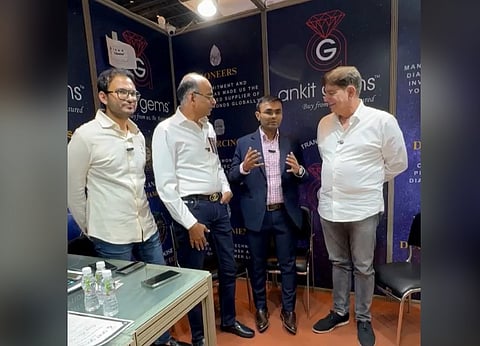

At IIJS 2025, Ankit Gems transformed its booth into a hub of dialogue and collaboration, hosting a powerful panel discussion that brought together key voices from across the diamond pipeline. Ankit Shah, Director of Ankit Gems Pvt. Ltd., welcomed Tehmasp Printer, Managing Director & CEO of IGI, and Sunil Modi of Jaipur Diamonds for a conversation that blended optimism, insight, and a shared vision for India’s diamond future.
Opening the session, Shah reflected on the importance of unity and collaboration within the trade. “We have two stalwarts here today, and I am so happy to have them with us. Since both are present, we began discussing what partnerships we can create—how we can shape win-win situations for everyone and prosper together,” he said.
The discussion quickly turned to the foundation of the diamond industry—trust. Printer observed that the enthusiasm at IIJS underscored India’s economic resilience. “We are nowhere close to a recession. In fact, we are only getting higher and growing all the way up. Trust is an inherent feature in this industry. If you have trust, you have everything,” he remarked.
Modi added that certification plays a crucial role in reinforcing that trust. “When it comes to selling goods, if it is IGI-certified, the confidence level is different. Certification has given customers the assurance they need, which has, in turn, given retailers the confidence to sell,” he said.
Shah connected these perspectives, noting that the certification process has deepened the chain of trust throughout the industry. “Earlier, trust was between the manufacturer and the retailer, and then the retailer to the consumer. IGI has placed a hallmark on that trust, assuring consumers they are making the right choice,” he explained.
The panel also explored shifting consumer tastes and design directions. “When it came to shapes, it used to be round,” said Modi. “But now the trend of fancy shapes has come, and confidence has followed with it.”
Printer praised Ankit Gems for anticipating and aligning with evolving consumer preferences. “Ankit is into fancy shapes, coloured diamonds, and much more—he has got what a consumer wants,” he said.
Acknowledging this synergy, Shah highlighted the role of retailers like Jaipur Diamonds in translating innovation into desirability. “Sunil delivers confidence to the consumer, making diamonds look beautiful in the jewellery designs they create. Now, an inquiry will be converted. A star is born—that’s what I see,” he added.
The discussion also looked ahead to India’s growing influence in the global diamond landscape. “Everybody together has to create transparency and awareness,” said Printer. “More awareness and transparency means more customers coming towards you, instead of running away.”
Shah echoed this sentiment with confidence in India’s trajectory. “Everybody says the next 10 years belong to India, but I believe it’s the next two to three decades. India is already the second-largest market for diamond jewellery. The potential is there to become the largest in the world—but it will take partnerships across the pipeline to make it happen,” he stated.
Printer concluded on a note of pride and heritage: “Diamonds originated from India, in the Golconda mines of Andhra Pradesh. They went around the world and have now come back home to roost. We have the ownership of diamonds in India again.”
For Ankit Gems, the session was more than a panel—it was a statement of purpose. By bringing together leading voices from manufacturing, certification, and retail, the company reaffirmed its commitment to fostering an ecosystem rooted in trust, transparency, and shared growth. The conversation served as a reminder that the future of India’s diamond industry will be shaped not by competition, but by collaboration.
